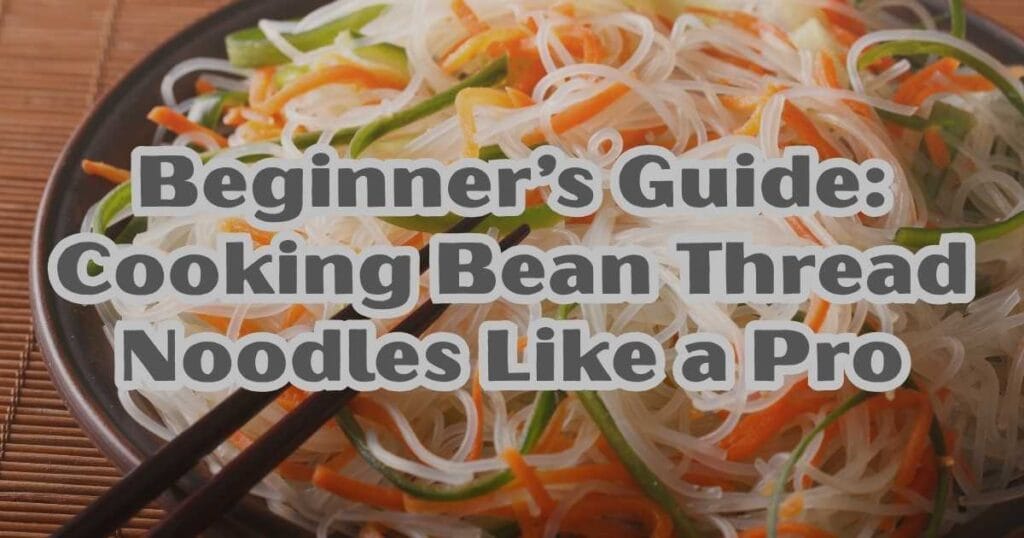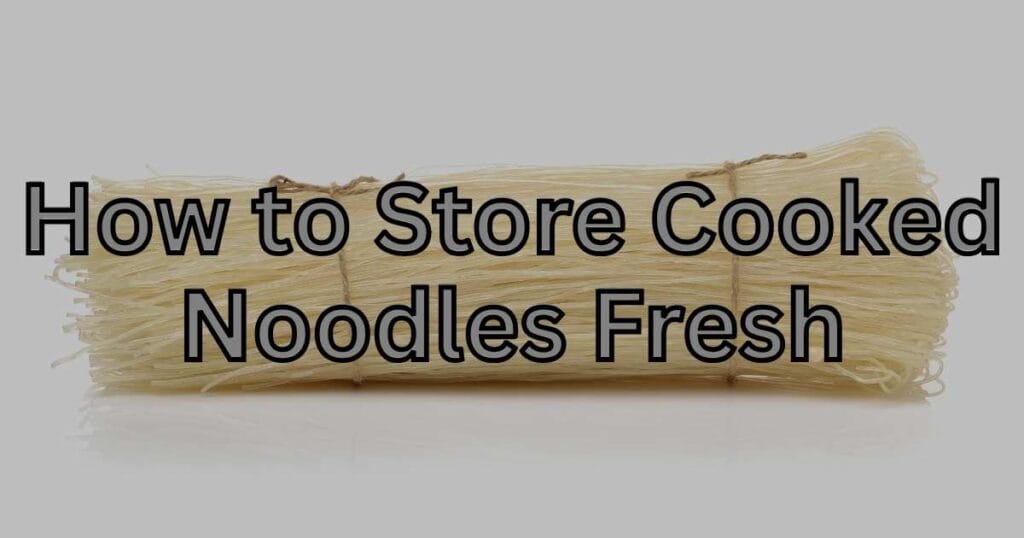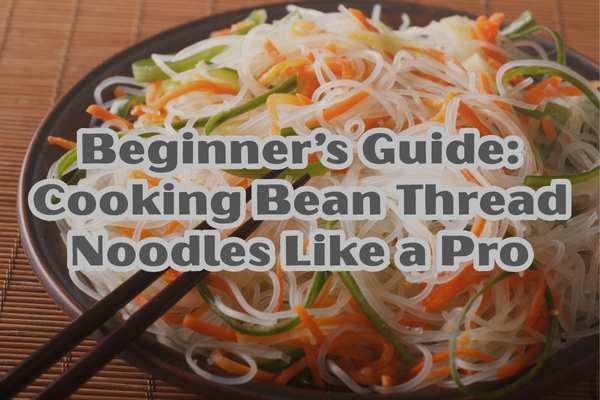Bean Vermicelli, also known as mung bean vermicelli, glass noodles or cellophane noodles, is a magical ingredient. You can use it to make great-tasting Asian dishes almost as soon as you take it home from the grocery store. Light and transparent, the noodle is delectable soaked in sauce as a dreamscape for your taste buds. From a comforting bowl of noodle soup to a crispy stir-fry, you can tuck it into any imaginable dish.
If you’ve ever struggled with soggy or sticky, overcooked noodles, don’t fret. This article – “Beginner’s Guide: Cooking Bean Thread Noodles Like a Pro” takes you step-by-step as a beginner to help you soak and season bean thread noodles and cook them like a pro.

What are bean vermicelli?
Bean thread noodles are made from mung bean starch along with water. once cooked, they become transparent—this is the origin of “glass noodle.” the noodles are gluten-free and low fat, and easily digestible.
The noodles do not turn mushy easily unlike rice or wheat noodles—finished hot in a soup or a cold salad, they keep right up.
KEY FEATURES
- Naturally gluten-free
- Made from mung bean starch
- Clear when cooked
- Eager to soak up surrounding flavors
Different Ways to Use Bean Thread Noodles
Bean vermicelli is extremely versatile. The most popular methods ant way are:
- Fried Rice: Stir it in with seafood vegetables and soy sauce to make a quick meal.
- Noodle Soup: Placed in boiling broth for a light satisfying texture.
- Spring Rolls: As a filling for a chew.
- Salads: Along with sesame dressing, herbs, and vegetables, to welcome the summer.
Step-by-Step Guide on how to cook bean vermicelli properly
Cooking bean thread noodles isn’t at all difficult—it’s just a matter of timing and texture. Heres how to get it right every time.
Step 1: Soak the noodles
First, add dry bean thread noodles cooking. Soak for 10-15 minutes in warm water. This softens the noodles ahead of cooking. Remember–don’t use water that is too hot! The noodles can soften uselessly before you even start cooking.
Pro Tip: When the noodles are flexible and transparent, move on to the next step.
Step 2: Drain and Rinse
When the noodles are soft, drain the water and rinse them in cold water. This stops the cooking process, and prevents the noodles from sticking together.
Step 3: Cook (Optional)
If your recipe needs cooking (e.g., soups, stir-fries), then boil the noodles just 1-2 minutes. Remember–bean thread noodles cook super fast! You can also add the soaked noodles to hot broth directly instead of boiling for soups.
Step 4: Toss/Stir-Fry
When cooked through, put the noodles into your mix of prepared sauce, salad or stir-fry. Let them soak up all of these flavours for at least 2-3 minutes before serving.
How to Prevent Noodles From Sticking Together

One common problem with glass noodles is that they clump together after cooking. Here’s How to Fix It:
- Rinse in cold water straight after boiling.
- Add some sesame oil or neutral oil before mixing up a little bit.
- Avoid overcrowding the pan by cooking little by small batches.
Flavour Combinations and Sauces That Are Best with Bean Thread Noodles
Bean thread noodles are like a blank canvas. Their mild flavor means you can pair them with seasoning and sauces that are unlimited.
Top Flavor Combos:
- Soy sauce + Sesame oil + Garlic = Classic Asian stir-fry base
- Chili oil + Vinegar = Spicy noodle salad
- Lime juice + Fish sauce + Sugar = Thai-style dressing
- Miso soup base + Tofu + Mushrooms = Comforting noodle soup
Common Mistakes to Avoid
Even though these noodles are easy to cook, beginners often make a few mistakes. Avoid these to get perfect noodles every time:
| Mistake | Result | Fix |
| Soaking in boiling water | Noodles become mushy | Use warm, not hot, water |
| Cooking too long | Sticky, clumpy noodles | Boil only 1–2 minutes |
| Not rinsing after boiling | Noodles stick together | Always rinse with cold water |
| Adding to cold stir-fry | Noodles turn dry | Add while pan is hot |
Bean Thread Noodles‘ Nutritional Content
These noodles are as healthy as they are tasty. And there are a number of reasons you can add beans in freely without feeling guilty at all:
- It’s low in calories-ideal for light meals.
- Without answer get it right now-you will get closure later.
- OK, to shift the Scale-axis and give just three morerioond turns counterclockwise until you hit the other bells again.
- Easily digested-
How to Store Cooked Noodles Fresh
When cooking bean thread noodles, storage is easy given the proper handling.

In the Refrigerator:
Store in an airtight container with a teaspoon of sesame oil mixed in, to prevent sticking; For 3-4 days.
In the Freezer:
Noodles may be frozen, but the texture changes. When reheating, always use a splash of water or broth.
Quick Bean Thread Noodle Stir-Fry Recipe
Materials:
- 200g bean thread noodles
- 1 tbsp sesame oil
- 1 clove garlic, minced
- 1 carrot, julienned
- ½ cup cabbage, shredded
- 2 tbsp soy sauce
- 1 tsp chili paste (optional)
- 1 green onion, chopped
How To Do:
- Soak noodles 10-15 minutes in hot water.
- Drain and snip into short lengths with scissors if desired.
- In a pan, heat sesame oil; sauté garlic and veggies for 2-3 minutes.
- Add soy sauce, chili paste, noodles; toss well another 2 minutes.
- Garnish with green onion and serve hot.
Frequently Asked Questions (FAQs)
1. Are bean thread noodles also called rice noodles?
No. Bean thread noodles are made from mung bean starch, turning transparent when cooked; rice noodles are made from rice flour and will remain white throughout their cooking process.
2. Can I reheat cooked bean thread noodles?
Sure, but remember to do it gently-just add a splash of water or broth; And heat gently over low heat so as not to be scorched from dry.
3. How long should I soak bean thread noodles?
Approximately 10-15 minutes in warm water is enough; They should be soft and pliant before cooking.
4. Are bean thread noodles healthy?
Certainly! They are gluten-free, low in calories and fat-free, enabling people looking for light, balanced meals to eat away without worryatrol.
5. Can I use bean thread noodles in cold salads?
Certainly! They ‘re perfect in cold spaghetti salads with soy, sesame or lime dressing.
Conclusion
Cooking bean thread noodles is easier than people think-it’s about timing and spice. Once you’ve mastered the soaking and cooking process, you’ll open up all sorts of possibilities for delicious stir-fries or soups with stir-fry vegetables, pork,bee chicken, anything! These are possibly the healthiest,lightest & certainly most versatile produkt you can have in your kitchen. So pick up a package of bean thread noodles for that quick pick-me-up lunch and go to town,anywhere you like!


